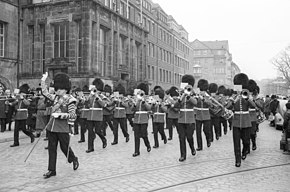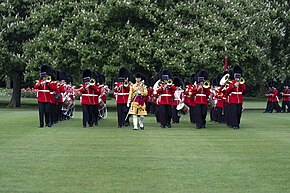Band of the Grenadier Guards
 From Wikipedia - Reading time: 5 min
From Wikipedia - Reading time: 5 min
Band of the Grenadier Guards | |
|---|---|
 The band on Horseguards Parade in London in 2008, rehearsing for Trooping the Colour | |
| Background information | |
| Also known as | Band of the Grenadier Guards |
| Origin | London, England, United Kingdom |
| Website | Band of the Grenadier Guards |
The Band of the Grenadier Guards is the military band of the Grenadier Guards, which is an infantry regiment of the British Army. It was raised between 1660 with first a drum and 1665, when a fife was added.
History
[edit]
The birth of the Grenadiers Band has been described to date from 1665, when each company had one soldier who had been instructed in playing the fife. In 1685, Charles II allowed the band to maintain 12 "hautbois" (oboe) players.[1] His death in 1685 was so significant for the band that until the Second World War, the Bass Drummer (known officially as The Regimental Timebeater), wore a black armband in mourning of the king's death.[2]
The march The British Grenadiers was introduced to British audiences in the late 17th century.[3]
George II gave Handel the task of scoring the Music for the Royal Fireworks, most commonly performed with strings, for the king's own musicians, who were wind players from his foot guards. Handel would have likely come into contact with musicians from the Grenadier Guards during the first performance at Vauxhall Gardens in 1749.[4]
By 1794, instrumentation included a flute player and sixteen others, namely six clarinets, three bassoons, three horns, one trumpet, two serpents and one drums.[1]
From 1856 to 1896 Lt. Daniel Godfrey MVO (1831–1903) was the bandmaster.[5]
In May 2008, the Band was given the freedom of the City of Lincoln.[6]


Functions
[edit]The Band of the Grenadier Guards plays regularly at various events as part of the Massed Bands of the Household Division; it can be found in London performing at the following occasions:[7]
Uniform
[edit]Full dress uniform of the Grenadier Guards worn on ceremonial occasions as in the band or the Household Division includes a tall and heavy fur cap, called bearskin.[8]
See also
[edit]References
[edit]- ^ a b "Droit History of the Grenadier Guards Band". Archived from the original on 8 October 2010. Retrieved 28 October 2008.
- ^ "The Grenadier Guards Band". The Musical Times. 48 (769). Musical Times Vol. 48, No. 769 (Mar. 1, 1907), pp. 149-155: 149–155. 1907. doi:10.2307/905027. JSTOR 905027.
- ^ Hart, Ernest (October 1918). "British Regimental Marches". The Musical Quarterly. 4 (4): 584. JSTOR 737882.
- ^ "A Brief History of Vauxhall Gardens". Retrieved 29 March 2020.
- ^ Hadden, James Cuthbert (1912). . In Lee, Sidney (ed.). Dictionary of National Biography (2nd supplement). Vol. 2. London: Smith, Elder & Co. p. 120.
- ^ "Official City Of Lincoln Press release". Retrieved 28 October 2008.
- ^ "The Band of the Grenadier Guards". The Household Division. Retrieved 17 July 2023.
- ^ Wharton, James (11 June 2021). "The Bearskin: Everything you need to know". BFBS. Retrieved 17 July 2023.
 KSF
KSF